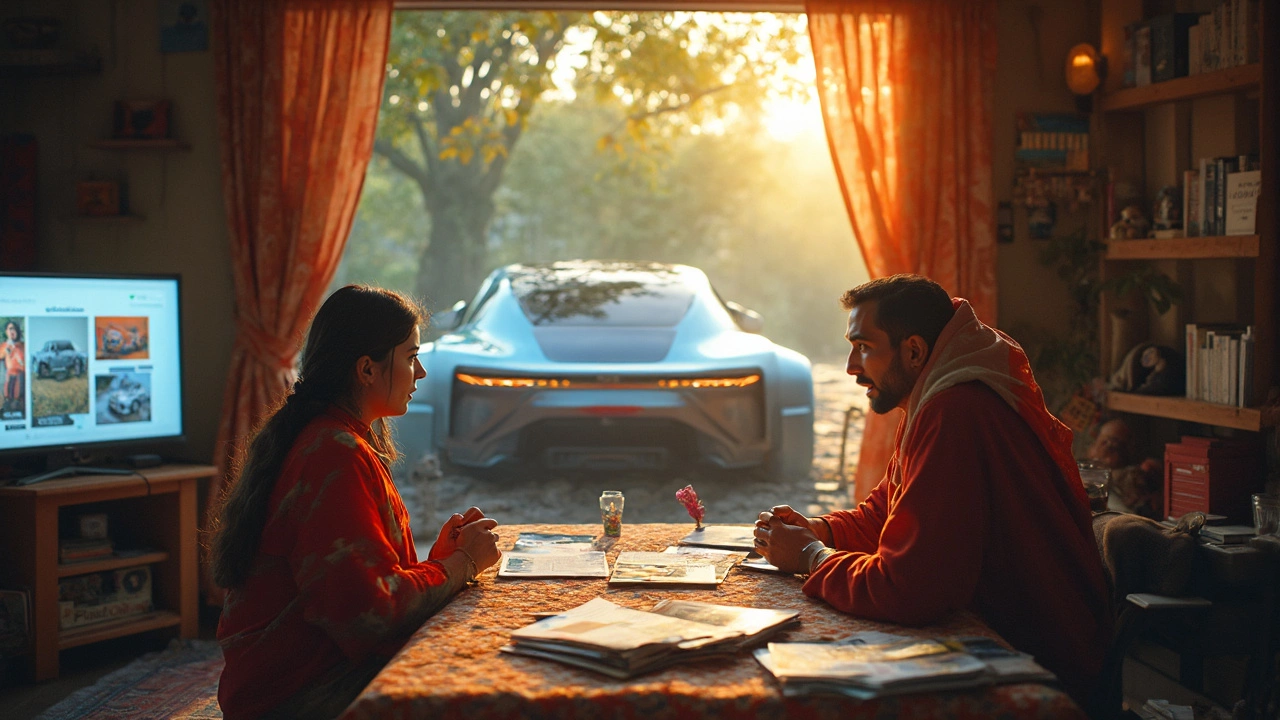So, what's the scoop on this 15-year car rule in India? In a country buzzing with cars of all shapes and sizes, it’s a rule that’s hard to miss. Once a car hits the 15-year mark from its manufacture date, it's technically considered eligible for de-registration. This can be quite a head-scratcher for car enthusiasts and everyday commuters alike!
What’s the whole point, you ask? It’s mainly about reducing pollution and easing congestion on roads. India’s urban areas are notoriously packed, and this rule aims to encourage folks to either stick with more eco-friendly rides or upgrade to fresher models.
But hang on, don’t think it’s just a dead end for your trusty vehicle. You've got options! You could apply for a re-registration to breathe new life into your old ride, or even better, consider transitioning to something greener! For car owners and manufacturers, knowing these options and how they align with the 15-year rule is key.
- The Essence of the Rule
- Impact on Car Owners
- Options After 15 Years
- Environmental Concerns and Benefits
- Future of Automobile Practices in India
The Essence of the Rule
Alright, let's get down to the nuts and bolts of the 15-year car rule in India. This rule is part of the country’s strategy to address rising pollution levels and manage the chaos of congested roads. So, why exactly 15 years? Well, by then, vehicles typically become less efficient, contributing more to air pollution and are often less safe on the road.
In practical terms, the rule means that once your car clocks 15 years from the date of its manufacture, it is considered for de-registration. This is particularly relevant in major cities where pollution and traffic are major concerns. The aim is to reduce the number of old vehicles that are more likely to spew out harmful emissions.
Implementation Details
The rule is enforced at the regional level by the respective state's transport authority. When your vehicle reaches the 15-year mark, the registration certificate (RC) effectively expires. Owners must either apply for re-registration – if it’s still roadworthy and passes the fitness test – or you might consider scrapping it altogether.
What Happens Next?
If you choose to re-register, it typically involves a detailed inspection process to ensure the vehicle meets certain safety and emission standards. However, if the car doesn’t make the cut, it could be time to say goodbye and upgrade to a newer model.
This table illustrates the steps and options available once vehicles reach this age:
| Action | Outcome |
|---|---|
| Re-registration | Vehicle stays on the road with a new RC, subject to passing fitness tests. |
| Scrapping | Vehicle is dismantled, recycling usable parts, and properly disposing of hazardous materials. |
| Upgrade | Switch to a newer, more efficient vehicle. |
It sounds like a hassle, but it's designed to push us towards cleaner and safer roads. It might seem tough for those attached to their old rides, but it’s a step towards a cleaner environment and healthier air for everyone.
Impact on Car Owners
The 15-year car rule can feel like a milestone that sneaks up faster than you think. If you've owned a car in India for a decade and a half, this rule is going to impact you in ways you might not expect.
Decisions, Decisions
One of the biggest impacts is what to do next. Once your car hits that magic number, you can choose to scrap it or try for a re-registration. Both options come with their pros and cons. Re-registration might get you a couple more years with your beloved vehicle, but it's not always a piece of cake logistically or financially.
Financial Considerations
Getting a re-registration can be a bit pricey. It involves a comprehensive fitness test and some paperwork, not to mention the additional tax. But if your car's engine is still in tip-top shape, it might be worth the expense. Of course, there’s the cost of a new or newer car to think about too. Whether it's a loan or a down payment, the financial aspect is a huge consideration.
Emotional Attachments
Let's not underestimate the emotional side. For many, a car is more than just a car. It's the countless road trips, late-night drives, and shared memories. Saying goodbye isn’t easy! That emotional tug is real, making the decision process even more difficult.
Environmental Responsibility
There's also the growing awareness of environmental impact. Older cars tend to be less efficient and more polluting. By switching to a newer vehicle, you're making a move that's kinder to the planet, especially if you go for a greener model, like an electric or hybrid vehicle.
| Option | Timeframe | Cost |
|---|---|---|
| Re-registration | 5 years max extension | ₹15,000 - ₹25,000 approx. |
| Scrapping | Immediate | Potential earning from scrap value |
So, if you find yourself reaching that 15-year mark, weigh these factors carefully. Your decision can impact not just your wallet but also your contribution to reducing road congestion and environmental pollution.

Options After 15 Years
Alright, so you've hit the 15-year mark with your car in India. What now? Don’t worry, all is not lost. There are a few paths you can take, each with its own benefits and considerations.
1. Re-Registration
If parting with your car feels like losing a family member, consider re-registration. This involves getting a fitness certificate, proving your vehicle's roadworthiness. It's like giving your car a second lease on life, but keep in mind that regulations may vary depending on the state you're in. Always check local rules before moving forward.
2. Scrapping
Sometimes, it's just time to say goodbye. If your car's on its last legs and re-registration seems like a hassle, scrapping might be the way to go. Many authorized centers offer scrapping services that ensure proper recycling of materials, keeping environmental impact in check. Plus, many manufacturers now offer discounts or bonuses on new vehicles if you scrap your old one.
3. Go Green
Old cars tend to be gas guzzlers. If you're considering an upgrade, this might be the perfect chance to switch to an eco-friendlier option. Electric cars or hybrid models are making waves in the market. They not only help clear the air but can also save you money on fuel and maintenance.
Making the Decision
Need help deciding? Consider factors like your car’s current condition, the costs involved, and your long-term needs. Consulting with a trusted automotive advisor can also provide clarity.
To wrap things up, hitting that 15-year milestone might seem daunting, but it's also a great opportunity for a fresh start. Whether you choose re-registration, scrapping, or going green, understanding your options makes for smooth sailing ahead!
Environmental Concerns and Benefits
Why does India push for the 15-year car rule? It's all about tackling the endless pollution issues and improving air quality. Older cars, especially those with outdated engines, are much bigger culprits in spewing out harmful emissions compared to their modern counterparts. That's why encouraging a switch to newer vehicles or eco-friendly models can make a world of difference for India's bustling cities.
One major concern is the carbon footprint left by these older vehicles. By replacing them, the country is taking steps toward cutting down on CO2 emissions, which contribute heavily to global warming. If you think about it, this not only benefits the environment but also our quality of life. Cleaner air means healthier communities.
Potential Benefits
Shifting to more sustainable models, like electric or hybrid cars, is a big win. Not only do they help in reducing emissions, but they’re also cheaper to run in the long term. How? Well, electric cars have fewer moving parts and often (surprisingly) lower-maintenance costs.
- Reduced Pollution: Newer cars generally meet stricter emissions standards.
- Better Fuel Efficiency: Thanks to improved tech, modern cars often offer better mileage.
- Enhanced Safety: Contemporary vehicles come with advanced safety features, which are a bonus for drivers.
| Vehicle Type | Average Emissions (g/km) |
|---|---|
| Older Petrol Vehicles | 180 |
| Modern Petrol Vehicles | 120 |
| Electric Vehicles | 0 |
It's not just about cutting emissions; the 15-year car rule nudges the automobile industry to innovate, bringing in fresh ideas for cleaner and greener technologies. This is a big opportunity for manufacturers to step up and help create a more sustainable future.

Future of Automobile Practices in India
Alright, let’s jump into the nitty-gritty of what's on the horizon for India's automobile scene. The 15-year car rule is just the start of a bigger journey towards sustainable transportation. With the Indian government pushing for greener roads, the implementation of this regulation is expected to shift gears towards more advanced automobile technologies.
Rise of Electric Vehicles (EVs)
To meet the growing eco-conscious demand, India is seeing a surge in Electric Vehicles (EVs). The government's policies have been encouraging the shift by offering subsidies and tax benefits. It's not just about hopping on the green bandwagon; these EVs are set to redefine how we think about convenience and performance on the road.
Scrappage Policies
Don't be surprised if you start hearing more about scrappage policies. As vehicles age, this initiative aims to take them off the roads efficiently, reducing environmental impact while reclaiming useful materials. It’s like giving that old clunker a new purpose! Plus, owners might snag incentives when buying new vehicles.
Shared Mobility Trends
With urban congestion getting more intense, people are looking for new ways to get from A to B. Enter shared mobility solutions like carpooling, ride-sharing, and on-demand shuttle services. They’re gaining momentum, offering flexibility and cost-effectiveness while reducing individual car ownership pressure.
Technological Innovations
India's automobile industry isn't just idling; it's revving up for some impressive tech advancements. From AI-enabled cars that drive themselves to smart infotainment systems, there’s a lot to look forward to. These innovations aim to enhance safety, improve the driving experience, and align with global standards.
In the context of policy and consumer behavior, it's crucial to stay in sync with these changes. Whether you’re a vehicle owner or part of the industry, understanding and adapting to these future trends can set you on the right road ahead.







Write a comment